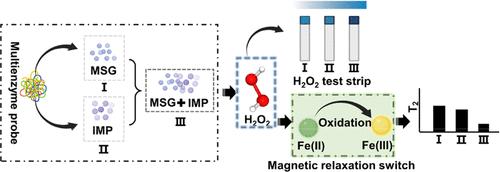Our official English website, www.x-mol.net, welcomes your feedback! (Note: you will need to create a separate account there.)
Multienzyme-Mediated Dual-Channel Magnetic Relaxation Switching Taste Biosensor (D-MRSTB) for Simultaneous Detection of Umami Compounds and Synergistic Enhancement in Food
ACS Sensors ( IF 8.9 ) Pub Date : 2024-04-11 , DOI: 10.1021/acssensors.3c02366 Liqin Kong 1 , Yongzhen Dong 2, 3 , Guoqiang Shu 1 , Yaoze Feng 1, 4, 5, 6 , Ming Zhu 1, 4
ACS Sensors ( IF 8.9 ) Pub Date : 2024-04-11 , DOI: 10.1021/acssensors.3c02366 Liqin Kong 1 , Yongzhen Dong 2, 3 , Guoqiang Shu 1 , Yaoze Feng 1, 4, 5, 6 , Ming Zhu 1, 4
Affiliation

|
Umami substances play a significant role in the evaluation of food quality, and their synergistic enhancement is of great importance in improving and intensifying food flavors and tastes. Current biosensors available for umami detection still confront challenges in simultaneous quantification of multiple umami substances and umami intensities. In this study, an innovative dual-channel magnetic relaxation switching taste biosensor (D-MRSTB) was developed for the quantitative detection of representative umami substances. The multienzyme signal of D-MRSTB specifically catalyzes the umami substances of interest to generate hydrogen peroxide (H2O2), which is then used to oxidate Fe2+ to Fe3+. Such a valence-state transition of paramagnetic ions was utilized as a magnetic relaxation signaling switch to influence the transverse magnetic relaxation time (T2) within the reaction milieu, thus achieving simultaneous detection of monosodium glutamate (MSG) and inosine 5′-monophosphate (IMP). The biosensor showed good linearity (R2 > 0.99) in the concentration range of 50–1000 and 10–1000 μmol/L, with limits of detection (LOD) of 0.61 and 0.09 μmol/L for MSG and IMP, respectively. Furthermore, the biosensor accurately characterized the synergistic effect of the mixed solution of IMP and MSG, where ΔT2 showed a good linear relationship with the equivalent umami concentration (EUC) of the mixed solution (R2 = 0.998). Moreover, the D-MRSTB successfully achieved the quantitative detection of umami compounds in real samples. This sensing technology provides a powerful tool for achieving the detection of synergistic enhancement among umami compounds and demonstrates its potential for application in the food industry.
中文翻译:

多酶介导的双通道磁弛豫切换味觉生物传感器 (D-MRSTB),用于同时检测食品中的鲜味化合物和协同增强
鲜味物质在食品品质评价中发挥着重要作用,它们的协同增强对于改善和强化食品风味和口感具有重要意义。目前可用于鲜味检测的生物传感器在同时定量多种鲜味物质和鲜味强度方面仍然面临挑战。在这项研究中,开发了一种创新的双通道磁弛豫开关味觉生物传感器(D-MRSTB),用于定量检测代表性鲜味物质。 D-MRSTB 的多酶信号特异性催化感兴趣的鲜味物质产生过氧化氢 (H 2 O 2 ),然后用于将 Fe 2+氧化为 Fe 3+。利用顺磁性离子的这种价态跃迁作为磁弛豫信号开关,影响反应环境内的横向磁弛豫时间(T 2),从而实现谷氨酸钠(MSG)和5′-肌苷磷酸的同时检测。 IMP)。该生物传感器在50-1000和10-1000 μmol/L的浓度范围内表现出良好的线性(R 2 > 0.99),MSG和IMP的检测限(LOD)分别为0.61和0.09 μmol/L。此外,该生物传感器准确地表征了IMP和MSG混合溶液的协同效应,其中ΔT 2与混合溶液的等效鲜味浓度(EUC)呈现良好的线性关系(R 2 = 0.998)。此外,D-MRSTB成功实现了实际样品中鲜味化合物的定量检测。该传感技术为实现鲜味化合物之间的协同增强检测提供了强大的工具,并展示了其在食品工业中的应用潜力。
更新日期:2024-04-11
中文翻译:

多酶介导的双通道磁弛豫切换味觉生物传感器 (D-MRSTB),用于同时检测食品中的鲜味化合物和协同增强
鲜味物质在食品品质评价中发挥着重要作用,它们的协同增强对于改善和强化食品风味和口感具有重要意义。目前可用于鲜味检测的生物传感器在同时定量多种鲜味物质和鲜味强度方面仍然面临挑战。在这项研究中,开发了一种创新的双通道磁弛豫开关味觉生物传感器(D-MRSTB),用于定量检测代表性鲜味物质。 D-MRSTB 的多酶信号特异性催化感兴趣的鲜味物质产生过氧化氢 (H 2 O 2 ),然后用于将 Fe 2+氧化为 Fe 3+。利用顺磁性离子的这种价态跃迁作为磁弛豫信号开关,影响反应环境内的横向磁弛豫时间(T 2),从而实现谷氨酸钠(MSG)和5′-肌苷磷酸的同时检测。 IMP)。该生物传感器在50-1000和10-1000 μmol/L的浓度范围内表现出良好的线性(R 2 > 0.99),MSG和IMP的检测限(LOD)分别为0.61和0.09 μmol/L。此外,该生物传感器准确地表征了IMP和MSG混合溶液的协同效应,其中ΔT 2与混合溶液的等效鲜味浓度(EUC)呈现良好的线性关系(R 2 = 0.998)。此外,D-MRSTB成功实现了实际样品中鲜味化合物的定量检测。该传感技术为实现鲜味化合物之间的协同增强检测提供了强大的工具,并展示了其在食品工业中的应用潜力。



























 京公网安备 11010802027423号
京公网安备 11010802027423号